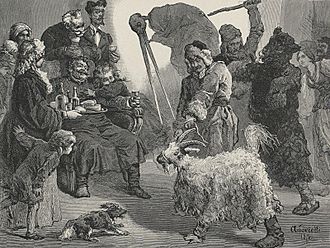Malanka facts for kids
Quick facts for kids Malanka |
|
|---|---|

Goat guiding
|
|
| Date | 13 January |
| Frequency | annual |
Malanka is a traditional folk holiday. It is celebrated in Ukraine and Belarus on January 13. This date is New Year's Eve according to the Julian calendar. People also call it the Old New Year.
Contents
What is the Story Behind Malanka?
Malanka comes from an old folk tale. This story has roots in ancient paganism but was later linked to Christian ideas. It tells about Mylanka, who was the daughter of a creator god. She was also known as "Spring-May" because she was very loving.
Mylanka's evil uncle, the Devil, wanted her in his underworld. One day, when the Moon was hunting, he took her away. While Mylanka was gone, the Earth stayed cold. Spring did not arrive, and nothing new grew.
When Mylanka was finally set free from the Devil, everything changed. Flowers began to bloom, and green plants spread across the world. People in Ukraine celebrate Malanka to welcome the start of spring. It symbolizes new life and growth.
How Do People Celebrate Malanka in Ukraine?
Malanka traditions in Ukraine involve special foods and fun activities.
Special Foods for Malanka
On the morning of Malanka, families prepare a special dish called "generous" kutia. This is a sweet grain dish. Unlike the kutia made for Christmas Eve, this one includes ingredients like meat or dairy. It is placed in the pokuttia, a special corner of the house. This corner is where religious icons are displayed.
Women also bake mlyntsi (pancakes). They make pyrihs and dumplings filled with cheese. These tasty treats are given to people who come to sing carols.
Food is very important on Malanka. People believe that having many different dishes on the table means a generous year ahead. The meals should be very filling. Eating fish is thought to be bad luck, as happiness might "pour out" of the home. Pork dishes are always prepared. This animal symbolizes plenty and good fortune in the house. Traditional pork dishes include kholodets (meat in aspic) and various sausages.
Caroling and Fun Activities
In the evenings, until midnight, carolers walk around the village. This tradition, like Christmas caroling, happens after sunset. This is when people believed evil spirits were active. Teenage girls often go alone or in groups to sing carols to their neighbors. They receive food and sweets as a reward.
Young men also take part in Malanka celebrations. This is called "leading Malanka." They wear masks and offer good wishes. They entertain people with funny songs, dances, and short plays. One young man usually dresses in women's clothes and is called Melanka.
After their caroling rounds, the young men have another tradition. The next morning, they burn the "Did" or "Didukh". This is a sheaf of grain that has been in the house since Christmas Eve. They burn it at a crossroads. Then, they jump over a bonfire. This act is meant to cleanse them after dealing with "evil spirits" all night.
Sowing Grain for Good Luck
The next day, as it gets light, young men go to "sow grain." They carry grain in a glove or a small bag. First, they visit their godparents and other relatives. Then, they visit their neighbors. When they enter a house, the sower throws grain around. They greet everyone with a New Year's wish:
I sow, I sow, I sow, I greet you with the New Year!
Good fortune, and good health in the New Year,
May your fields bear better this year than last,
Rye, wheat and any grains,
Hemp piled to the ceiling in large rolls.
Be healthy for the New Year and Basil's Day!
God grant us this!
People believe that the first sower to visit on New Year's Day brings good luck. It is thought that only boys bring happiness. So, girls usually do not go "sowing."
Malanka Celebrations in North America
In North America, Ukrainian groups organize Malanka events. These events are often held in banquet halls. They are like Ukrainian versions of a New Year's Eve ball. They usually happen about a week after Christmas Eve (Old Calendar). They might not be exactly on January 13 or 14. Instead, they are often on a Friday or Saturday night close to that date.
These "Malanky" gatherings bring the local Ukrainian community together. People enjoy themselves and honor their cultural background. They come ready to socialize and celebrate the New Year with friends and family. The event usually includes a nice dinner. There are often raffles and prizes to win. The night usually ends with a zabava (dance).
At midnight, everyone cheers for the New Year. Then, individual and pair polka dancing stops. The kolomyjka, a lively Ukrainian dance, begins. After the kolomyjka finishes, everyone goes back to their other dancing. They continue to party late into the night. Malanka is often the last chance for celebrations before the serious period of Lent. Lent is a time of fasting that comes before Easter.

